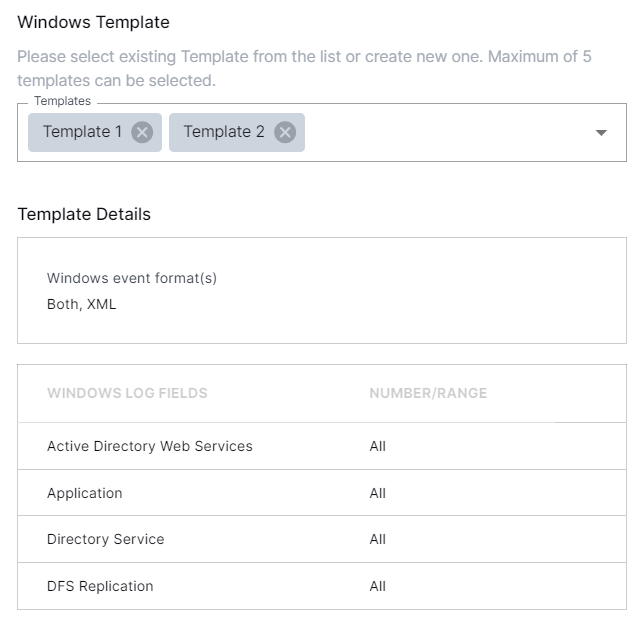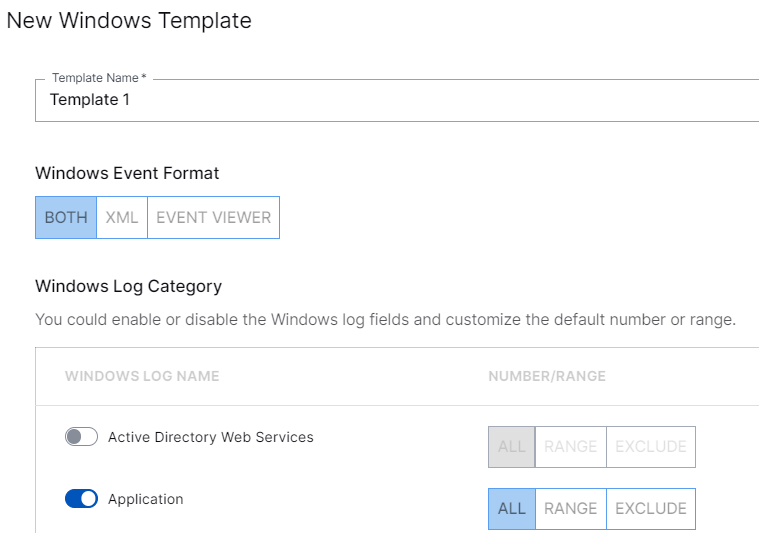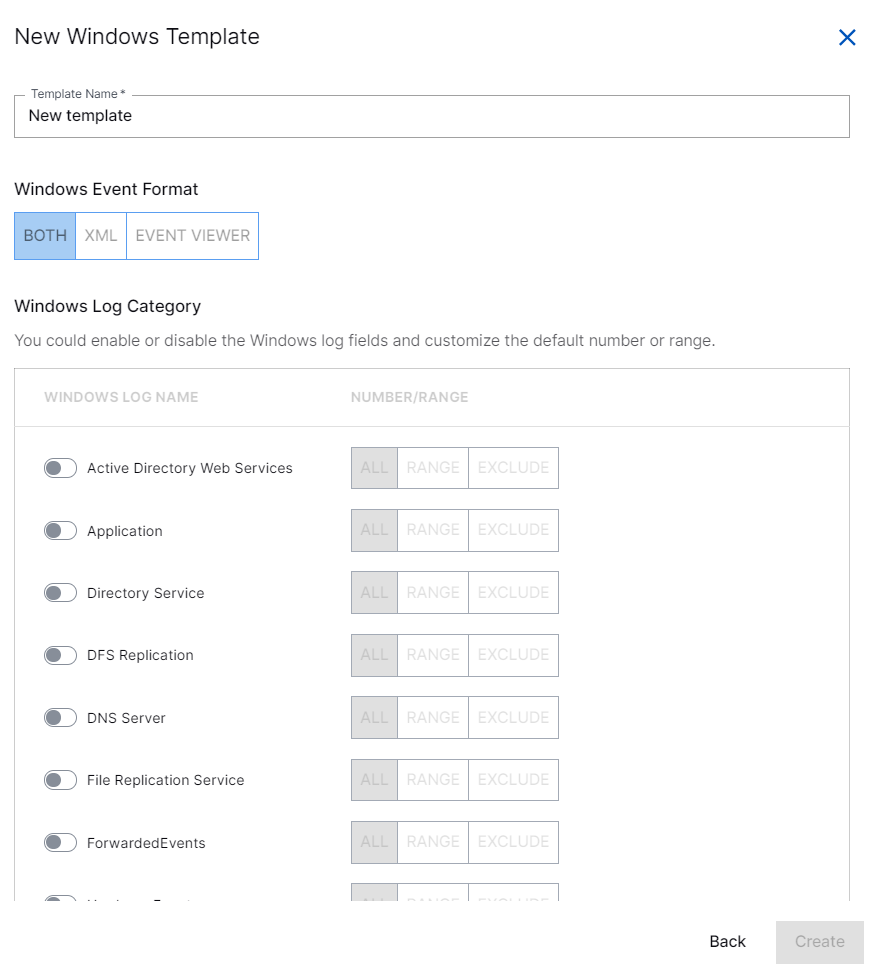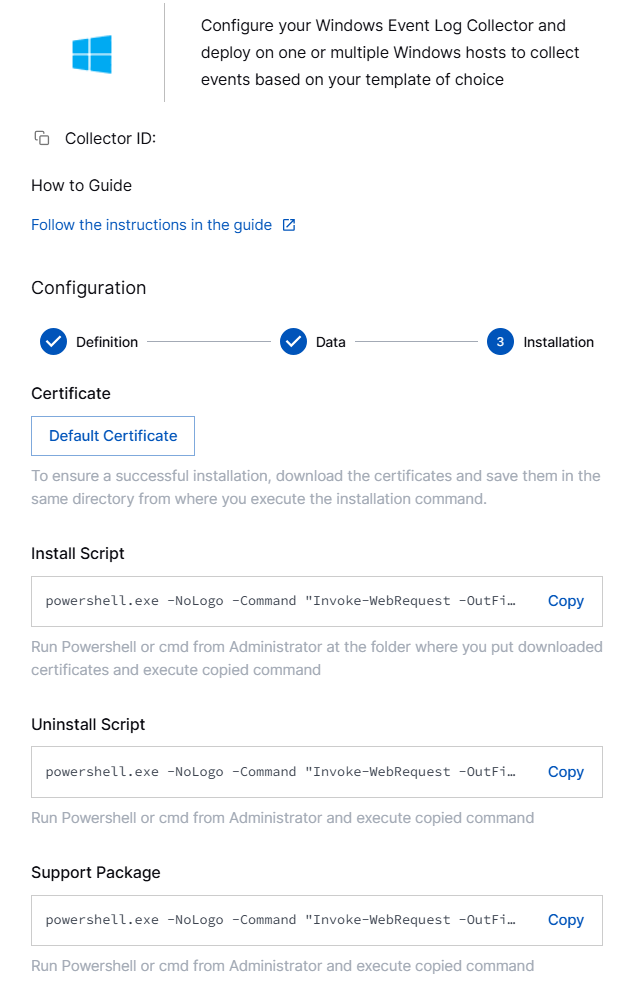- Site Collector Overview
- Get Started with Site Collectors
- Install Site Collector
- Set Up Collectors
- Sign Up for the Early Access Program: Site Collectors
- Choose the Right Collector based on Data Sources
- Set Up Archive Windows Collector
- Set Up Archive Linux Collector
- Set Up EStreamer Collector
- Set Up Fortinet Collector
- Set Up IBM Security QRadar Collector
- Set Up Kafka Collector
- Set Up Splunk Collector
- Set Up Linux File Collector
- Set Up Microsoft SQL Collector
- Set Up MySQL Collector
- Set Up Oracle Collector
- Set Up Syslog Collector
- Set Up Windows Active Directory Collector
- Set Up Windows Event Log Collector
- Set Up Windows File Collector
- Manage Site Collectors
- Apply Antivirus Exclusions
- Migrate to the New-Scale Site Collectors Service
- Modify Collector Configuration
- Modify a Site Collector Instance
- Manage Templates
- Monitor Log Sources
- Add Filters to Set Egress Log Filtering Conditions
- New Site Collector Management Service NGSCD
- Regenerate Certificates for Collectors
- Upgrade the Site Collector
- Upgrade the Site Collector Specifications
- Site Collector Monitoring
- Troubleshoot the Site Collector
- Pre-checks failed during Site Collector installation and upgrade
- Site Collector UI shows the status INSTALLATION_ERROR
- Download Support Packages for Troubleshooting
- How to reboot the Virtual Machine (VM) successfully to apply security updates?
- What information must be added while creating a support ticket to resolve an issue?
- Site Collector UI is not displaying the heartbeats
- Splunk Collector can't be set up
- Splunk Collector is set up however, logs are not reaching DL/AA
- Only a few of the installed Splunk Collectors are processing logs or EPS has dropped by 50% as compared to last hour
- The Windows Active Directory Collector (formerly known as LDAP Collector) is set up, however, the context data is not reaching DL/AA
- The Windows Active Directory Collector (formerly known as LDAP Collector) is stuck in the ‘Update’ mode after deployment
- Installation is initiated; however, the collector shows the status as ‘Setting Up’ for some time
- Data Lake and Advanced Analytics Does Not Show Context Data
- Context Data from Windows Active Directory Collector is Segmented
- Minifi Permission Denied - Logback.xml File Missing and Config File Update - Failed Error Occurred while Installing the Windows Event Log Collector
- Where should I upload proxy certificates if I am running proxy with TLS interception?
- How to upgrade Linux collector instance?
Set Up Windows Event Log Collector
Set up the Windows Event Log Collector to retrieve logs natively from your Windows server. The Windows Event Log Collector is a set of Site Collector flows, pre-built processors, groups, custom processors, other components, and integrations that pull logs in XML, Event Viewer format (called as Friendly View in Windows Journal), or both from your Windows server and push the logs to New-Scale Security Operations Platform. The collector provides flexible template configuration capabilities to collect Windows events.
Tip
If you configure a Windows Event Log Collector instance for a Site Collector instance which was created using a hostname, you may get a 'Request timed out' error while establishing communication with the host VM from a Windows VM. To avoid the 'Request timed out' error and ‘Setup error’, ensure that you complete the following steps on your Windows VM.
Type ping hostname_of_site_collector in your Windows command prompt. If this command succeeds, proceed with installing a Windows Event Log Collector for this Site Collector instance. If you get a ‘Request timed out’, or ‘Cannot resolve host’ or ‘Unknown host’ error, use the following steps.
Open the hosts file that maintains mapping between hostname and IP_address, located at: C:\Windows\System32\drivers\etc\hosts, using Notepad.
Add a new entry with your hostname and IP address at the end of the file for example, hostnname_of_site_collector ip_address
Save the hosts file.
Proceed to install a Windows Event Log Collector instance for this Site Collector instance.
To set up a Windows Event Log Collector:
Log in to the New-Scale Security Operations Platform with your registered credentials.
Navigate to Collectors > Site Collectors.
Ensure that Site Collector is installed and in running state.
On the Site Collector page, click the Collectors Library tab, then click Windows.

In the Definition section, enter the required information as follows.

Collector Name – Site Collector generates a name for the Windows Event Log collector based on your hostname.
Site Collector Instance – Select the site collector instance for which you want to set up the Windows Event Log Collector.
Log Ingestion Start Date – Select the date from which you want the Windows Event Log Collector to collect events.
Now (Default) – Retain the default option Now if you want the collector to pull all the logs registered immediately after collector installation time.
1 Week Ago – Select this option if you want the collector to start pulling logs one week before the date of collector installation. For example, if you installed the collector instance on September 27, the collector instance starts pulling logs from September 20, 00:00 UTC, irrespective of the installation time.
2 Weeks Ago – Select this option if you want the collector to start pulling logs two weeks before the time of collector installation.
3 Weeks Ago – Select this option if you want the collector to start pulling logs three weeks before the time of collector installation.
4 Weeks Ago – Select this option if you want the collector to start pulling logs four weeks before the time of collector installation.
All Time – Select All Time if you want the collector to collect all the data that is available on the Windows server.
Click Next.
In the Data section, set up the Windows template while configuring the collector. After you create a template, you can reuse the template for other collector instances or create a new template each time you set up a new Windows Event Log Collector.

Windows Template – Select preconfigured templates to filter logs, or, create a new template. Templates enable you to filter logs by attribute values.

You can select one or up to five preconfigured templates. If you select templates with conflicting conditions, the collector instance may pull duplicate data. To avoid data duplication, it is recommended to create templates with different conditions. For example:
Log Conditions for Template 1

Log Conditions for Template 2

Log Conditions for Template 3

By clicking +New Windows Template, you can create and apply up to five templates.
To create a new Windows template:
In the Templates list, click New Windows Template.
In the Template Name field, specify a name for the new Windows template.

In the Windows Event Format section, select the format: XML, Event Viewer format (called as Friendly View in Windows Journal), or both, in which you want the Collector to pull logs.
In the Windows Log Category section, for filtering logs, enable the log fields that you want to use and select the appropriate option: All, Range, and Exclude.
All – Click All to include all types of logs irrespective of the value. The collector collects all events for the specified Windows Log name.
Range – Click Range and specify a range in the box that appears next. The collector collects security events based on the defined range.
Exclude – Click Exclude and specify a value for the events to be rejected while log collection in the box that appears next. The collector collects all the security events from the specified Windows Log name excluding the events listed in this section.

Use the Advanced Settings section to configure advanced settings to optimize the Windows Event Log Collector performance based on the hardware of the windows systems such as CPU, memory, and disk IOPS.
Batch Commit Size – Enter the number of records to commit per batch. By default, 1000 events are collected and grouped before they are sent to the Site Collectors instance. Lowering the batch size can increase events per second (EPS), but it also raises disk IOPS (Input/Output Operations Per Second).
Event Batch Read Size – Enter the number of events to read per batch. By default, 100 events are retrieved from the Windows journal per query. This increases EPS and reduces disk IOPS, but uses more memory.
Substitute Percentage Items – Enable to replace placeholder symbols (%%) in raw XML with readable text or IDs. It improves data clarity, but uses significant CPU resources and may lower EPS. You can disable it to boost EPS. However, ensure that data parsing works correctly. By default this option is enabled.
SID Lookup – Enable Security Identifiers (SID) lookup to convert Security Identifiers (SIDs) into readable names. Enabling this option may lower EPS. By default, this option is enabled. Disable this option to improve performance.
Cache SID – This option is applicable only if SID Lookup is enabled. By default, this option is enabled which adds caching to improve SID lookup speed but increases memory usage. Disabling this option saves memory but may reduce performance.
Click Create.
The Windows template is created.
In the Installation section, copy the scripts and download certificates as follows.

Certificate – Click Default Certificate to download the certificates. After you download the certificates, ensure that you save the certificates in the same directory from where you execute the installation command.
Note
After the security certificate expires, the collector may continue to deliver data for several hours because the collector maintains active connections that were created and authenticated before the certificate expiration.
Install Script – Copy the Install script. Paste the script in the PowerShell or CMD command line interface as an administrator and run the copied command to install the Windows collector.
Note
You can use one install script for installing Windows Event Log Collector on multiple Windows machines.
Uninstall Script – To uninstall the Windows collector, copy and run the script using PowerShell or CMD interface as an administrator. You must execute the script on the windows server.
For a Windows collector instance you want to uninstall or delete, it is recommended to first use the Delete option on the Overview page. If the delete action fails, copy and run the uninstallation script in Windows Server PowerShell as an administrator. Then, delete the Windows collector instance again from the Overview page to complete the cleanup.

Support Package – Copy and run the support package command using PowerShell to share the support package with the support team for troubleshooting and remediation of issues if any.
Verify that the Collector installed. After you run the Install script on your Windows server, you get a confirmation message about successful collector installation and the Collector instance is listed in the Overview section on the user interface.
The Windows Event Log Collector is set up and is ready to pull Windows events from your Windows server.
After the Windows collector is set up, Site Collector Core starts pulling logs periodically based on your template configuration and uploads logs to New-Scale Security Operations Platform. If the Windows server is not available, Site Collector core resumes pulling logs from the place where it stopped.
In case of installation failure, the collector is disabled, and the configuration is saved. You can check the status of the collector on the user interface or by using the support package.
Note
The supported versions of Windows operating system are Windows 10, Windows 11, Windows Server 2016, Windows Server 2016 core, Windows Sever 2019, Windows Server 2019 core, Windows Server 2022, and Windows Server 2022 core.
The Windows Event Log Collector installation through a proxy or VPN is not supported.
The agent-based collectors use mutual TLS (mTLS) for authentication for installation, which requires the collector to connect using actual IP address of Site Collector to establish a secure connection. Network Address Translation (NAT) is not supported because it causes authentication failures and prevents installation. This restriction applies irrespective of proxy or VPN usage. Similarly, any configuration that involves NAT or TLS inspection—including those without proxy or VPN—will result in authentication failure and installation errors.
CrowdStrike may interfere with the operation of Windows Agent collectors. To avoid disruptions, ensure that you:
Whitelist the collector and management services. For example, for WELC, Exabeam Windows Collector service and Exabeam WELC Management service.
Provide read/write access to the installation folder of the agent collector and C:\Windows\Temp.
Ports for Windows Event Log Collector Configuration
For deploying Windows Event Log Collector, refer to the following table to configure the ports that match your environment.
Source | Destination | Port | Protocol | Description |
|---|---|---|---|---|
Windows Event Log Collector | Site Collector Host | 8080 | HTTPS | Use this port to enable access from Windows server (not external network access) to Site Collector host. |
Windows Event Log Collector | Site Collector Host | 8899 | HTTPS | Use this port to push data from Windows Event Log Collector to Site Collector. |
Windows Event Log Collector | Site Collector Host | 8880 | HTTPS | Use this port for C2 Server for communication between Minifi (Windows Event Log Collector) and Nifi (WEP). |
Windows Event Log Collector | Site Collector Host | 9875 | HTTP | Use this port to download the Windows Collector installer and installation script. |
Windows Event Log Collector | Site Collector Host | 9876 | HTTPS | Use this port to monitor installation progress from Windows Event Log Collector to Site Collector backend. |
Windows Event Log Collector | Site Collector Host | 9877 | HTTPS | Management Windows |
Windows Event Log Collector | Site Collector Host | 9878 | HTTPS | Use this port to perform remote actions such as upgrade and deletion. |
Windows Event Log Collector | Site Collector Host | 9879 | HTTPS | Use this port to perform remote actions such as upgrade and deletion. |
Note
The network ports required for Windows Event Log Collector configuration are also required for Windows File Collector configuration.